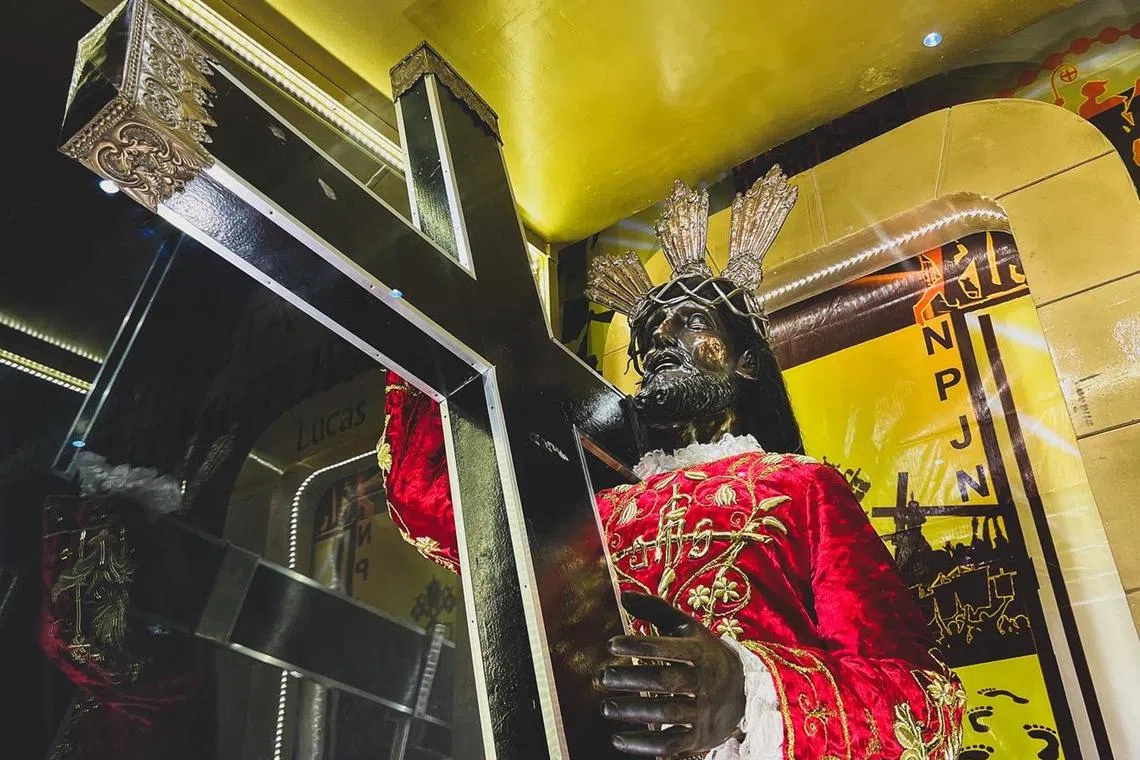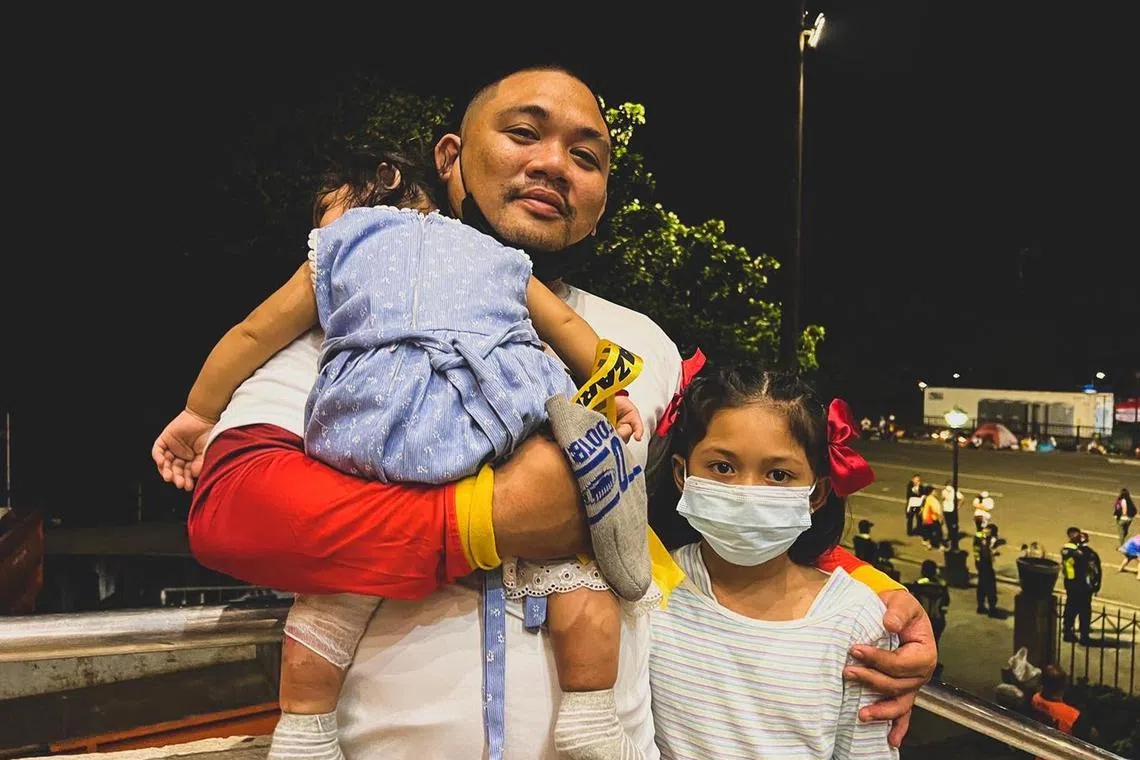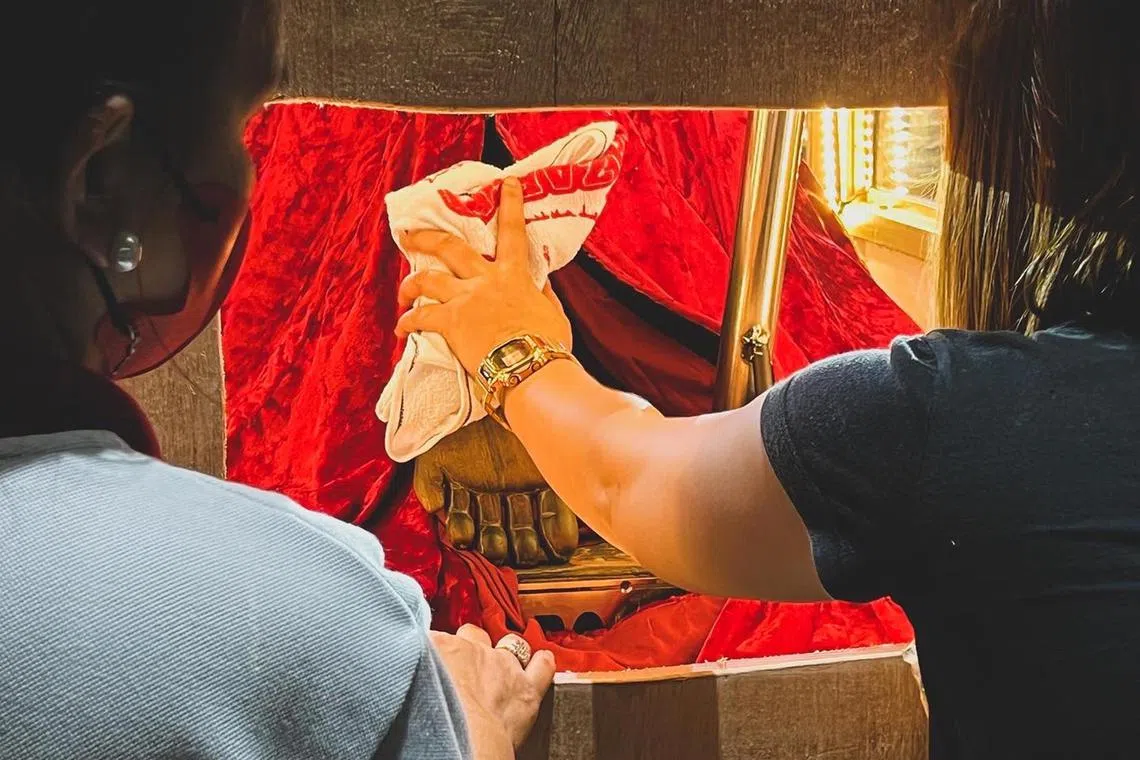Tens of thousands flock to Manila for Black Nazarene feast as Covid-19 rules eased
Sign up now: Get ST's newsletters delivered to your inbox

Devotees attending midnight mass for the Black Nazarene Feast in Manila on Sunday.
ST PHOTO: MARA CEPEDA
Follow topic:
MANILA - Thousands of devotees of a 17th-century statue of a dark-skinned Jesus Christ thronged the streets of Manila over the weekend, as relaxed Covid-19 rules allowed people to venerate the Black Nazarene up close.
Over 88,000 people joined the 6km procession held in the early hours of Sunday, though this was only a fraction of the mammoth crowd that used to come together every Jan 9 for a chance to pray before the life-sized effigy they believe can perform miracles.
The Feast of the Black Nazarene, or the Nazareno, is the biggest religious event in the predominantly Catholic Philippines and one of the largest displays of religious fervour in the world.
The statue was brought to Manila by Augustinian friars from Mexico in 1607. It is believed the effigy acquired its dark colour after it was charred when the ship carrying it caught fire.
Before the pandemic, a million barefoot devotees would join the hours-long Traslacion, or transfer procession, where the Nazareno is paraded from the grandstand in the capital’s biggest park to Quiapo Church.

A replica of the Black Nazarene at a grandstand in Manila on Sunday.
ST PHOTO: MARA CEPEDA
It was common for worshippers to jostle to hold on to the ropes used to pull the Nazareno’s carriage and climb on top of other people’s shoulders just to touch and wipe towels on the effigy.
For believers, every drop of sweat, tears and blood they shed is an expression of their sacrifice and gratitude for the blessings that came their way because of the Nazareno’s intercession.
There was no such chaos this year, as church authorities cancelled the Traslacion for a third time due to Covid-19.
But unlike the past two years, when only hourly masses were held for the Black Nazarene Feast, the procession was allowed this year – though devotees could not march alongside the Nazareno.
The rebranded “Walk of Faith” procession was also held a day before the feast day.
Devotees were encouraged to wear face masks and to observe social distancing. The unvaccinated were advised against attending Black Nazarene activities.
Among the devotees disappointed by the Traslacion’s repeated cancellation was 33-year-old Mr John Terrence Nacional, who calls the Nazareno ninong or godfather, and credits it for saving his wife and firstborn during a life-threatening childbirth.
“We were able to hold an election last year when thousands attended rallies. Concerts with huge crowds are back. But it seems we’re neglecting God this time,” said Mr Nacional, a member of the Hijos del Nazareno group that guards the image during past Traslacions.
“But maybe this is what Godfather wanted. The procession this year was orderly and no one got hurt.”

Mr John Terrence Nacional has been teaching his daughters about his long-time devotion to the Black Nazarene.
ST PHOTO: MARA CEPEDA

Devotees taking part in the “Walk of Faith” procession for the Black Nazarene in Manila on Sunday.
ST PHOTO: MARA CEPEDA
Worshippers instead brought smaller replicas of the effigy, murmuring their prayers as they walked with their lighted candles.
Over 538,000 devotees also joined the masses held at Quiapo Church from Saturday to Monday, where they could gaze at the original Black Nazarene statue displayed on the church’s terrace.
Three kilometres away at a grandstand in the city’s historic park where national hero Jose Rizal was executed by Spanish colonialists, a Black Nazarene replica was also displayed so that devotees could touch and wipe towels on its feet.
People would even kiss its feet pre-pandemic, but this was disallowed this year.
Housewife Jessa Morite, 27, and her extended family set up camp on the grandstand’s grounds on Saturday to secure a clear view of the Nazareno replica.
She said her second child had a convulsion years ago and she and her husband, a construction worker, could only pray to the Black Nazarene as they had no money for medical treatment.
They believed the Nazareno healed their son, who has been healthy since then.
“We made sure we can see the image from our tent. We couldn’t go near it in the past. It’s important for us to be here because we can feel the Nazareno’s presence with us,” she said.

Housewife Jessa Morite brought a small replica of the Black Nazarene as her family set up camp for a two-night stay near the grandstand, where devotees pay homage to a bigger replica of the statue.
ST PHOTO: MARA CEPEDA

A woman uses a cloth to wipe the feet of the replica of the Black Nazarene, which Filipino Catholic devotees believe has the power to perform miracles.
ST PHOTO: MARA CEPEDA
Despite the Covid-19 restrictions, many devotees were grateful that more in-person activities have returned.
Some said they prayed for a healthy, prosperous life and hoped for the end of the pandemic that has redefined the way they celebrated this religious feast.
Parents like Mr Nacional brought their kids along to keep the Nazareno spirit alive.
“I want my children to learn the story of the Nazareno and how he helped our family,” he said, cradling his sleeping daughter in his arms while another held his hand. “I want all my descendants to continue our vow of devotion in the years to come.”


